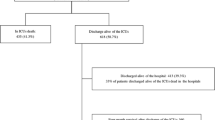Abstract
Admission of cancer patients with serious medical complications to the ICU remains controversial primarily because of the high short-term mortality rates in these patients. However, the cancer patient population is heterogeneous regarding age, underlying conditions, and curability of their disease, suggesting that large variations may occur in the effectiveness of intensive care within this subgroup of critically ill patients.¶Objectives: To identify factors predicting 30-day mortality in patients with solid tumors admitted to a medical ICU.¶Patients and methods: We conducted a retrospective study in 120 consecutive cancer patients (excluding patients with hematological malignancies) admitted to the medical ICU of a 650-bed university hospital between January 1990 and July 1997. Medical history, physical and laboratory test findings at admission, and therapeutic interventions within the first 24 h in the ICU were recorded. The study endpoint was vital status 30 days after ICU admission. Stepwise logistic regression was used to identify independent prognostic factors.¶Results: The observed 30-day mortality rate was 58.7 % (n = 68), with most deaths (92 %) occurring in the ICU. Univariate predictors of 30-day mortality were either protective [prior surgery for the cancer (p = 0.01) and complete remission (p = 0.01)] or associated with higher mortality [Knaus scale C or D (p = 0.02), shock (p = 0.04), need for vasopressors (p = 0.0006) or for mechanical ventilation (p = 0.0001), SAPS II score greater than 36 (p = 0.0001), LOD score greater than 6 (p = 0.0001), and ODIN score > 2 (p = 0.0001)]. Three variables were independent predictors: previous surgery for the cancer (OR 0.20, 95 % CI 0.07–0.58), LOD score > 6 (OR 1.26, 95 % CI 1.09–1.44), and need for mechanical ventilation (OR 3.55, 95 % CI; 1.26–6.7). Variables previously thought to be indicative of a poor prognosis (i. e., advanced age, metastatic or progressive disease, neutropenia or bone marrow transplantation) were not predictive of outcome.¶Conclusion: When transfer to an ICU is considered an option by patients and physicians, 30-day mortality is better estimated by an evaluation of acute organ dysfunction than by the characteristics of the underlying malignancy.
Similar content being viewed by others
Author information
Authors and Affiliations
Additional information
Received: 18. August 1999/Final revision received: 25. April 2000/Accepted: 26 April 2000
Rights and permissions
About this article
Cite this article
Azoulay, E., Moreau, D., Alberti, C. et al. Predictors of short-term mortality in critically ill patients with solid malignancies. Intensive Care Med 26, 1817–1823 (2000). https://doi.org/10.1007/s001340051350
Published:
Issue Date:
DOI: https://doi.org/10.1007/s001340051350




